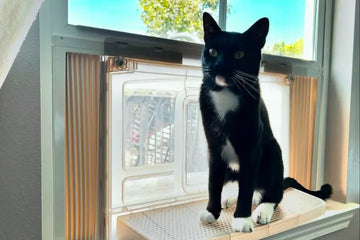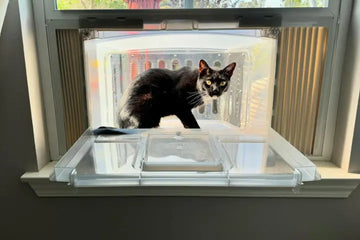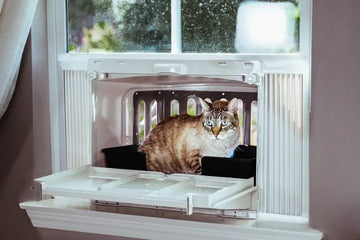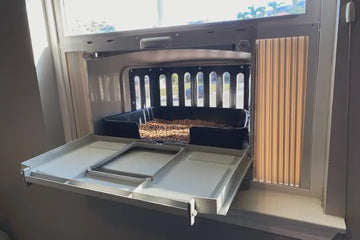Reducing stress in cats is essential for their overall health and well-being. One effective way to achieve this is through the use of litter box enclosures. These enclosures provide a private and secure space for cats, which can help minimize their anxiety and promote better litter box habits. In this blog post, we will explore the benefits of cat litter box enclosures, the different types available, and how to choose the right one for your home. Additionally, we will discuss complementary products and strategies to further reduce cat stress.
Cat Stress and Litter Box Usage
Cats are naturally sensitive creatures, and many factors can contribute to their stress levels. One significant source of stress for cats is their litter box environment. A poorly placed or exposed litter box can make cats feel vulnerable and anxious. This discomfort can lead to inappropriate elimination behavior, such as urinating outside the litter box. Cat litter box furniture, like enclosures, offers a solution by providing a private, stress-free area for cats to do their business.
Importance of Reducing Cat Stress
How to relieve cat stress is a common concern among cat owners. Chronic stress can lead to various health issues in cats, including urinary tract problems, digestive issues, and behavioral changes. By addressing the sources of stress, such as the litter box environment, you can significantly improve your cat's quality of life. A cat stress reducer like a litter box enclosure not only helps in managing stress but also promotes overall well-being.
What We Will Cover
This blog post aims to educate cat owners on the benefits of using cat litter box enclosures to create a more comfortable and stress-free environment for their feline friends. We will cover the advantages of these enclosures, the different types available, and tips for choosing and placing them in your home. Additionally, we will explore other stress reducing products for cats and practical strategies to help you maintain a clean and harmonious living space for your pets.
Benefits of Litter Box Enclosures
Using a cat box enclosure offers numerous benefits for both cats and their owners. These enclosures can help create a more pleasant living environment by reducing odors and providing a private space for cats to use the litter box comfortably.
- Creating a Private and Secure Space: A hidden cat litter box provides a private and secure space for your cat, reducing their anxiety and making them feel more comfortable. Cats are instinctively private when it comes to elimination, and an exposed litter box can make them feel vulnerable. By providing an enclosed space, you can help your cat feel safer and more relaxed, leading to better litter box habits and less stress.
- Enhancing Home Aesthetics: Cat litter box furniture can also enhance the aesthetics of your home. Traditional litter boxes can be an eyesore, especially in small living spaces. An enclosure can hide the litter box, blending seamlessly with your home decor. Hidden cat litter box furniture comes in various styles and finishes, allowing you to choose a design that complements your home's interior while keeping the litter box out of sight.
- Reducing Anxiety and Stress Triggers: Stress triggers such as loud noises, high traffic areas, or other pets can make a cat feel anxious when using the litter box. A cat litter enclosure can shield your cat from these stressors, creating a calm and quiet space for them. By reducing exposure to potential stress triggers, enclosures can help decrease your cat's overall anxiety and contribute to a more peaceful household.
- Promoting Good Litter Box Habits: Providing a hidden litter box furniture can promote good litter box habits in your cat. Cats are more likely to use the litter box consistently if they feel safe and comfortable. An enclosure helps maintain a clean and private environment, encouraging regular use. This can prevent inappropriate elimination behaviors, making life easier for both you and your cat.
Types of Litter Box Enclosures
There are various types of litter box enclosures available, each offering unique features to suit different needs and preferences. Understanding these options can help you choose the best one for your home and your cat.
Cat Litter Box Furniture
Cat litter box furniture is designed to look like regular household furniture, such as cabinets, benches, or side tables, while discreetly hiding the litter box. This type of enclosure not only provides a private space for your cat but also serves a functional purpose in your home. With various designs and finishes available, you can find a piece that matches your decor and offers a practical solution for concealing the litter box.
Hidden Cat Litter Box Furniture
Hidden cat litter box furniture takes discretion to the next level by completely concealing the litter box within a piece of furniture. These enclosures often feature doors or panels that blend seamlessly with the rest of the furniture, making the litter box virtually invisible. This option is ideal for those who want to maintain a clean and stylish home without compromising their cat's comfort and privacy.
Various Designs and Styles
Litter box enclosures come in a wide range of designs and styles to suit different tastes and needs. From modern and minimalist designs to more traditional and ornate pieces, there is something for everyone. Consider your home's decor and your cat's preferences when choosing an enclosure. Some enclosures also come with additional features, such as ventilation systems or built-in storage for litter and cleaning supplies.
Choosing the Right Type for Your Home
When selecting a cat litter enclosure, consider factors such as the size of your cat, the available space in your home, and your aesthetic preferences. Ensure that the enclosure is large enough for your cat to move comfortably and that it provides adequate ventilation. Think about where you plan to place the enclosure and how it will fit with your existing furniture. By considering these factors, you can find the perfect litter box enclosure for your home and your cat.
Choosing the Right Litter Box Enclosure
Selecting the right litter box enclosure is crucial for ensuring your cat's comfort and maintaining a clean, stress-free environment. Here are some key considerations to keep in mind when choosing an enclosure.
Size Considerations
The size of the enclosure should be large enough to accommodate your cat comfortably. Your cat should be able to enter, turn around, and dig without feeling cramped. If you have a larger cat or multiple cats, opt for a bigger enclosure to ensure they have enough space. A properly sized enclosure can make a significant difference in your cat's willingness to use the litter box.
Ensuring Proper Ventilation
Proper ventilation is essential for maintaining a clean and odor-free environment inside the enclosure. Look for enclosures with ventilation holes or panels that allow air to circulate. This helps prevent odor buildup and ensures that your cat has fresh air while using the litter box. A well-ventilated enclosure can contribute to a more pleasant living environment for both you and your cat.
Accessibility for Cleaning
Choose an enclosure that is easy to clean and maintain. Look for designs with removable panels or doors that provide easy access to the litter box. This makes it simpler to scoop the litter and perform regular cleanings. An accessible enclosure ensures that you can maintain a high level of hygiene, which is crucial for how to decrease stress in cats.
Factors to Consider for Multiple Cats
If you have multiple cats, consider their individual needs and preferences when selecting an enclosure. Ensure that the enclosure is large enough to accommodate multiple cats if they share a litter box. Alternatively, provide separate enclosures for each cat to prevent territorial disputes and ensure that each cat has a private space. This can help maintain harmony in a multi-cat household and reduce stress for all your pets.
Placement of Litter Box Enclosures
The placement of your cat box enclosure plays a significant role in its effectiveness. Choosing the right location can help create a comfortable and stress-free environment for your cat.
- Ideal Locations in the Home: Place the cat box enclosure in a quiet and low-traffic area of your home. This helps create a private and secure space for your cat. Avoid placing the enclosure near loud appliances or busy areas where your cat might feel exposed or anxious. A calm and peaceful location encourages regular use and helps reduce stress.
- Avoiding Busy or Noisy Areas: Avoid placing the cat litter enclosure in busy or noisy areas of your home. High-traffic areas, such as hallways or near doorways, can make your cat feel vulnerable and stressed. Choose a location that is quiet and away from household commotion to provide a more relaxing environment for your cat.
- Creating a Safe and Quiet Environment: Ensure that the area around the enclosure is safe and quiet. Remove any potential stressors, such as loud noises or sudden movements. Providing a peaceful environment helps your cat feel more secure and reduces anxiety. A stress-free space encourages your cat to use the litter box consistently and comfortably.
- Tips for Discreet Placement: Consider discreet placement options to blend the enclosure seamlessly with your home decor. Place the enclosure in a corner or against a wall to keep it out of sight. Use furniture or decorative screens to hide the enclosure while still providing easy access for your cat. Discreet placement ensures that the enclosure serves its purpose without disrupting the aesthetics of your home.
Complementary Stress-Reducing Products for Cats
In addition to using a cat litter box enclosure, there are various stress reducing products for cats that can help create a more comfortable environment. These products can complement the benefits of the enclosure and further reduce your cat's stress levels.
Calming Sprays and Pheromone Diffusers
Calming sprays and pheromone diffusers can help create a soothing environment for your cat. These products release synthetic pheromones that mimic the natural calming signals cats produce. By using these stress relievers for cats in combination with a hidden cat litter box, you can create a more relaxing and secure space for your feline friend.
Stress-Relief Treats and Supplements
Stress-relief treats and supplements can help reduce your cat's anxiety and promote a sense of calm. These products often contain natural ingredients like chamomile, valerian root, and L-theanine, which are known for their calming effects. Incorporating these treats and supplements into your cat's routine can be an effective stress reliever for cats, complementing the use of a cat litter box enclosure.
Interactive Toys and Playtime
Interactive toys and regular playtime are essential for reducing stress in cats. Engaging your cat in physical and mental activities helps distract them from stressors and promotes overall well-being. Toys that stimulate hunting instincts, such as feather wands and laser pointers, can provide much-needed exercise and mental stimulation. Consistent playtime also strengthens the bond between you and your cat, further reducing their anxiety.
Safe Hiding Spots and Comfort Zones
Providing safe hiding spots and comfort zones around your home can help your cat feel more secure. Cats often seek out secluded areas when they are stressed. Creating dedicated hiding spots with soft bedding and familiar scents can offer a refuge for your cat. These areas can serve as additional stress reducing products for cats, complementing the use of a cat litter enclosure.
Understanding and Recognizing Cat Stress
Recognizing the signs of stress in your cat is crucial for addressing their needs and improving their environment. Understanding these signs and triggers helps you take proactive steps to reduce cat stress.
Signs of Anxiety in Cats
Common signs of anxiety in cats include excessive grooming, changes in eating habits, hiding, and aggression. If your cat is exhibiting these behaviors, it may be experiencing stress. By recognizing these signs early, you can take steps to create a more comfortable environment, such as introducing a hidden litter box furniture.
Behavioral Indicators of Stress
Behavioral indicators of stress in cats can also include inappropriate elimination, scratching furniture, and vocalization. These behaviors are often a response to changes in their environment or routine. Providing a cat box enclosure and other stress reducing products for cats can help alleviate these stress-related behaviors.
Common Stress Triggers
Common stress triggers for cats include changes in their environment, the introduction of new pets or people, loud noises, and a lack of privacy. Identifying and minimizing these triggers can help create a more stable and comfortable environment for your cat. For instance, using a hidden cat litter box can provide the privacy your cat needs to feel secure.
Proactive Steps to Relieve Cat Stress
Taking proactive steps to relieve cat stress involves creating a predictable routine, providing a safe and quiet environment, and using cat stress reducer products. Regularly cleaning the litter box, providing fresh water and food, and ensuring your cat has access to comfortable resting areas are all important aspects of how to decrease stress in cats.
Maintaining a Clean and Odor-Free Environment
A clean and odor-free environment is essential for reducing stress in cats. Regular maintenance and high-quality products can make a significant difference in your cat's comfort and well-being.
Regular Cleaning Routine
- Establishing a regular cleaning routine for the litter box is crucial. Scoop the litter daily and change it entirely at least once a week. This prevents odor buildup and ensures a hygienic environment for your cat. A clean litter box is more inviting and reduces the likelihood of stress-related behaviors.
Using High-Quality Litter
- Using high-quality litter can help control odors and provide a more pleasant experience for your cat. Clumping litters are often preferred as they make cleaning easier and help keep the litter box fresher for longer. Experiment with different types of litter to find the one that best suits your cat's preferences and needs.
Preventing Odor Buildup
- Preventing odor buildup involves not only regular cleaning but also using products designed to neutralize odors. Deodorizers and air purifiers can help keep the area around the litter box smelling fresh. Proper ventilation in the cat litter enclosure also aids in reducing unpleasant smells.
Importance of Hygiene in Reducing Stress
- Maintaining high standards of hygiene is important for how to relieve cat stress. A clean and odor-free litter box environment helps prevent health issues and makes your cat feel more comfortable. Regular cleaning and proper maintenance are key components of a stress-free environment for your feline friend.
Strategies for Multi-Cat Households
Managing a multi-cat household comes with unique challenges, especially when it comes to litter box usage. Implementing the right strategies can help ensure harmony and reduce stress among your cats.
Providing Multiple Litter Boxes
- Providing multiple litter boxes is essential in a multi-cat household. A good rule of thumb is to have one litter box per cat plus one extra. This ensures that each cat has access to a clean litter box at all times, reducing territorial disputes and promoting better litter box habits.
Preventing Territorial Disputes
- Preventing territorial disputes involves strategically placing litter boxes in different areas of the house. Ensure that each cat has its own space and that no litter box is in a high-traffic or noisy area. This minimizes the chances of one cat guarding the litter box and intimidating others.
Ensuring Easy Access for All Cats
- Ensure that all cats have easy access to their litter boxes. Avoid placing litter boxes in areas that are difficult to reach or that require navigating obstacles. Easy access helps prevent accidents and ensures that all cats can use the litter box comfortably.
Tips for Harmonious Coexistence
- Creating a harmonious environment involves providing enough resources, such as food, water, and resting areas, for all cats. Regularly monitor your cats' behavior and address any signs of stress or conflict promptly. Using hidden litter box furniture can also help by providing private spaces for each cat to feel secure.
Practical Tips for Reducing Cat Stress
Implementing practical tips can make a significant difference in reducing your cat's stress levels and creating a happier home environment.
Creating a Routine
Creating a routine helps your cat feel more secure and less stressed. Regular feeding times, play sessions, and cleaning schedules provide predictability and stability. Cats thrive on routine, and maintaining consistency can significantly reduce anxiety.
Gradual Introduction to New Enclosures
When introducing a new cat litter box enclosure, do so gradually. Allow your cat to explore the enclosure at its own pace, and use positive reinforcement to encourage its use. A gradual introduction helps your cat adjust to the new environment without feeling overwhelmed.
Providing Consistent Care and Attention
Providing consistent care and attention is crucial for your cat's well-being. Spend quality time with your cat, engage in regular play, and offer affection. Consistent care helps build trust and reduces stress, creating a stronger bond between you and your cat.
Consulting with a Veterinarian for Persistent Issues
If your cat continues to show signs of stress despite your efforts, consult with a veterinarian. Persistent stress can indicate underlying health issues that need to be addressed. A veterinarian can provide guidance on how to relieve cat stress and recommend appropriate treatments or interventions.
Suggested Articles and Books on Cat Care
Expand your knowledge with suggested articles and books on cat care. Resources like "The Cat Whisperer" by Mieshelle Nagelschneider and "Catification" by Jackson Galaxy and Kate Benjamin offer valuable insights. These books provide in-depth advice on understanding cat behavior and creating an environment that reduces stress. Articles from trusted sources such as the ASPCA and PetMD also offer practical tips and up-to-date information on cat care.
Access to Online Forums and Support Groups
Join online forums and support groups for cat owners. These communities provide a platform to share experiences, seek advice, and connect with others who understand the challenges of caring for cats. Websites like The Cat Site and Reddit's r/cats are excellent places to start. Engaging with these communities can provide support, new ideas, and a sense of camaraderie among fellow cat lovers.
Links to Stress-Reducing Products
Explore a range of stress reducing products for cats to enhance your efforts in creating a calm environment. Products such as calming sprays, pheromone diffusers, and stress-relief treats can be highly effective. Check out online retailers like Chewy and Amazon for a variety of options. These products can be a valuable addition to your strategy for maintaining a stress-free home for your cat.
Summarizing The Benefits of Litter Box Enclosures
Using a cat litter box enclosure provides numerous benefits, including reducing stress, enhancing home aesthetics, and promoting better litter box habits. These enclosures create a private and secure space for your cat, helping them feel more comfortable and relaxed.
Reducing Cat Stress
Reducing cat stress involves creating a comfortable and secure environment, maintaining cleanliness, and providing consistent care. By addressing the sources of stress and implementing effective strategies, you can significantly improve your cat's quality of life.
Implement Stress-Reducing Strategies
We encourage you to implement the stress-reducing strategies discussed in this blog post. From using hidden cat litter box furniture to providing interactive toys and maintaining a routine, these steps can make a significant difference in your cat's well-being. Remember, a happy cat is a healthy cat.
Tips for a Happy and Healthy Cat
Remember to be patient and observant, as each cat has unique needs and preferences. By understanding your cat's behavior and providing a supportive environment, you can help your feline friend lead a happy and healthy life. Regular veterinary check-ups, proper nutrition, and lots of love and attention are essential components of a comprehensive approach to cat care.
By following these guidelines and utilizing the suggested resources, you can create a stress-free environment for your cat, ensuring they are happy, healthy, and well-adjusted.

















































